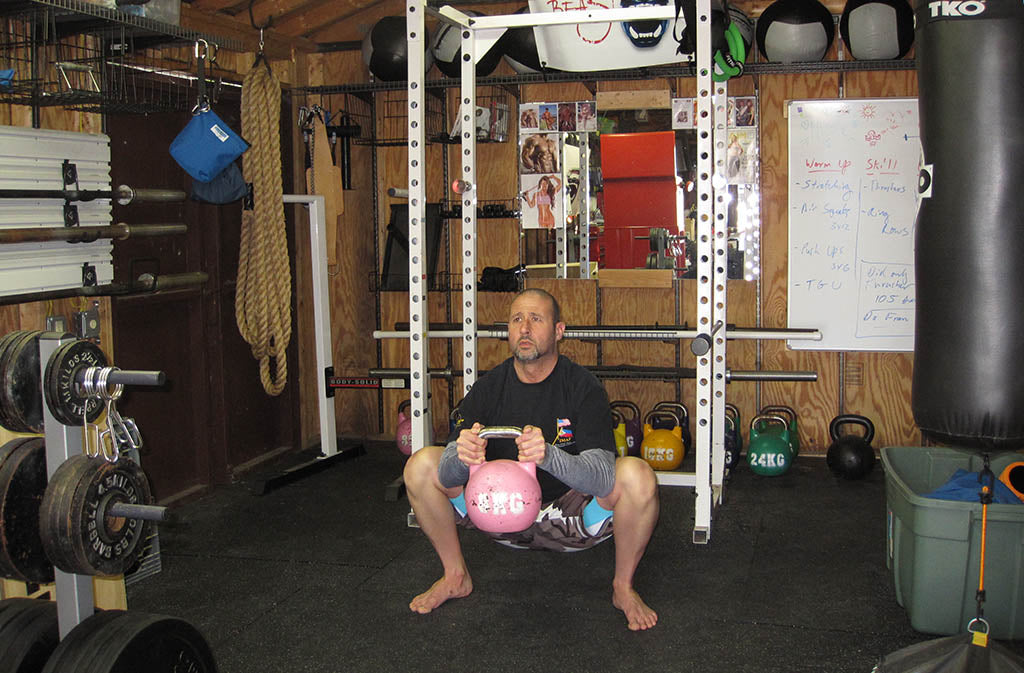Advanced Squat Guide Part 2: Weighted Variations, Self-Coaching & Circuits
This is a guest blog post by Adam Farrah, author of The Paleo Dieter’s Missing Link and Functional Fitness, Kettlebell, Yoga and Meditation coach.

In Part 1 of the Ultimate Guide to the Squat, we reviewed the basics of good squatting technique and how to fix common problems, but in this second part, we will introduce advanced techniques to take your squat even further.
By taking an unweighted squat and adding an external load, such as a barbell, a dumbbell, or a kettlebell, you significantly increase the challenge and provide the body with a powerful stimulus for muscle mass and strength gains, but you also increase the risk.
Why Advanced Squat Technique & Variations Matter
Mastering the basic squat is only the beginning. Once your movement pattern is solid, stepping into loaded variations (barbell front squat, back squat, goblet squat) and using corrective drills (box-squats, bands on knees, sumo deadlift-squat hybrids) not only builds muscle and strength, it enhances mobility, reduces injury risk, and improves your athletic potential. These advanced techniques depend heavily on sharp cues, proper load progression, and attention to your body’s mechanics.
In this article, you will learn:
- Corrective exercises to fix your squat
- Self-coaching cues to keep your squat on track
- Weighted squat variations
- Advanced squat-based circuit training workouts
Fixing the Squat: Corrective Exercises
As a coach, I take pride in the fact that I can assess the movement patterns of virtually anyone I work with. And over the years, I’ve collected an assortment of exercises and drills that I use to correct movement problems. I use verbal cueing with my clients—and we’ll go over some of those cues shortly—but learning to move well is a physical skill.
As a result, it needs to be drilled physically and with repetition, to help put the patterns into the body and make them stick.
My initial sessions with new clients tend to focus pretty heavily on these corrective exercises. Sometimes, the entire workout is spent just fixing a basic, unweighted squat. Once the basic movement pattern is there, we’ll do the exercises less frequently, and I’ll bring them out just for a warm-up or a touch-up on form, especially when they relate to the workout.
For example, if the workout is going to be something like a 5-rep max on front squats, I’ll incorporate box squats into the warm-up to both warm up and get in more reps of form practice right before we tackle a related movement.
1. The Box Squat
The box squat is squatting with a box behind to allow an exaggerated “hips back” squat form. The box basically catches the trainee as they sit back into the squat. This is the best exercise I’ve ever found for fixing form when the trainee initiates the movement with the knees instead of the hips, and also for teaching the proper hip movement in the squat, deadlift, kettlebell swing, and other movements. The box squat. Note how far back I’m sitting, and that my shins are straight up and down.

2. The Kettlebell Sumo Deadlift
Similar to the box squat, the kettlebell sumo deadlift is a great exercise for teaching proper “hips back” form for squatting, deadlifting, or the kettlebell swing. Once box squat form is strong, the kettlebell sumo deadlift allows the loading of the movement, but takes the skill of handling a weighted barbell out of it, so the focus can be on the leg drive and hip movement.


Dr. Mark Cheng likens the above position to the posture of a silverback Gorilla—strong.
3. The Goblet Squat
I consider this one more of a flexibility movement than an exercise. It works great for opening the inner thighs and reinforces a deep, hips-back squat because the kettlebell counterbalances the hips and keeps the trainee from falling back. In the box squat, we used the box to “catch” us at the bottom. In this case, we avoid falling back because the kettlebell changes the weight distribution. Work down into the goblet squat slowly over several minutes. Pry the knees open with the elbows and work the hips side to side to move deeper into the position. Make sure to come out of the position slowly too!

4. Band on the Knees
A light band around the knees is a great way to bring awareness to knees that knock in. A few reps with a band can do a lot to eliminate knees that knock in at the start of the drive-up in the squat. A light band is plenty to train the knees to pry out during the squat. Note that my shins are tracking over my feet, and my toes are gripping the floor.

Fixing the Squat: Coaching Cues
These are the main coaching cues I use both for training clients and coaching myself. During a workout with weight, there isn’t a lot of focus left over for detailed form cues, so I limit coaching to very basic commands like “Hips, hips, hips,” “Open chest,” or “Sit back, sit back” on the eccentric, and then I’ll switch to “Pry the knees” right before the drive up. I give these cues to my clients to focus their attention on the place that needs it the most in the movement. I also say them to myself during training to stay focused on a specific portion of the movement that I need to concentrate on. The best strategy is to cue only one thing at a time, and make it highly relevant to the part of the movement the trainee is in and what they need to focus on—either as a correction or to reaffirm a focus point in the movement.
1. Hips First, Hips Back
A good squat starts at the hips. The squat is initiated when the hip flexors “pull” the body down into the squat. The very first observable body movement should be the glutes moving back as the squat starts. This is why the box squat is such a great coaching tool. It exaggerates this movement so it can be “felt” strongly enough to create awareness that will translate into the regular squat. Move the hips first and sit them back. My cue for this one is “Sit back, sit back.”
2. Pry the Knees Out
Prying the knees is a cue I learned from Dr. Mark Cheng. It serves two purposes. First, it puts a mental focus in place that keeps the knees from knocking in. Second, it encourages the hips and torso to reach the proper depth by sitting down between the knees and “into the bucket.” My cue here is “Knees, knees” or “Pry the knees.”
3. Torso Upright, T-Spine Open
The thoracic portion of the spine—the T-spine—should be neutral or in slight extension. But we tend to hunch over our laptops, our desks, our phones, and our steering wheels. And when we squat, we tend to do the same: the upper back rounds and the chest closes in. A verbal cue like “Big chest, big chest” or “Elbows up and in” (for the barbell front squat, specifically) is what I use for this particular aspect of squatting form.
Weighted Squat Variations and Styles
1. The Barbell Front Squat
This is my favorite squat movement with kettlebells or a barbell. I strongly prefer it to the back squat for most training, mainly because it encourages an upright torso and an open T-spine. We all sit too much, and most of us naturally tend toward a collapsed chest and rounded upper back. Heavy back squatting can really reinforce that posture in someone who is already spending too much time in it.
2. The Kettlebell Front Squat
This exercise is one of my all-time favorites. Not only does it have all the advantages of the barbell front squat as far as posture goes, but it also reinforces a proper kettlebell rack, which also applies to the kettlebell clean and any overhead kettlebell pressing movement.
3. The Back Squat
The back squat has been considered “the king of the exercises” for somewhere around 100 years. It’s one of the “big three” basic barbell exercises—squat, bench press, and deadlift—and a competition power lift. Of all the squat variations, it’s the one you can pack the most weight onto and, thus, use to pack the most muscle onto yourself. Just remember that it can also be a slightly dangerous exercise without a squat rack or a strong and attentive spotter.
Advanced Squat Workouts
To get your creative groove flowing, here are a few basic workouts that give plenty of air squat reps. One is a classic CrossFit workout, the second is an all-bodyweight workout, and the third is a workout I use from time to time that combines air squats and a weighted movement.
1. "Cindy"
5 pull-ups, 10 push-ups, 15 air squats. As many rounds as possible in 20 minutes
2. Tabata
As many air squats as possible in 20 seconds, followed by 10 seconds of rest. Repeat for 8 rounds (4 minutes). Difficulty can be dramatically increased by “resting” in the bottom position for the 10-second rest period
3. 100 Reps for Rounds
50 air squats, 25 push-ups, 25 kettlebell swings, 50 sit-ups, 3 to 5 rounds for time (depending on fitness level)
Conclusion
How’s your squat form? Did these corrective exercises help? Do you have a favorite one to add? Let us know in the comments!
Frequently Asked Questions (FAQ)
- What are the best corrective exercises for improving squat form? Exercises like box squats for hip-back movement, kettlebell sumo deadlifts for hip drive and banded knee drills for knee tracking are highly effective.
- Which squat variations should I use once I’ve mastered the basic pattern? Start with front squats for upright torso, goblet squats for mobility, and traditional back squats for maximal loading—progress gradually.
- How do I coach myself during weighted squats to avoid injury? Use simple verbal cues like “hips back”, “knees out”, “chest up"; video yourself for feedback; start light; and gradually load once form is consistent.
(Want articles like this via email? Here's the sign up!)

